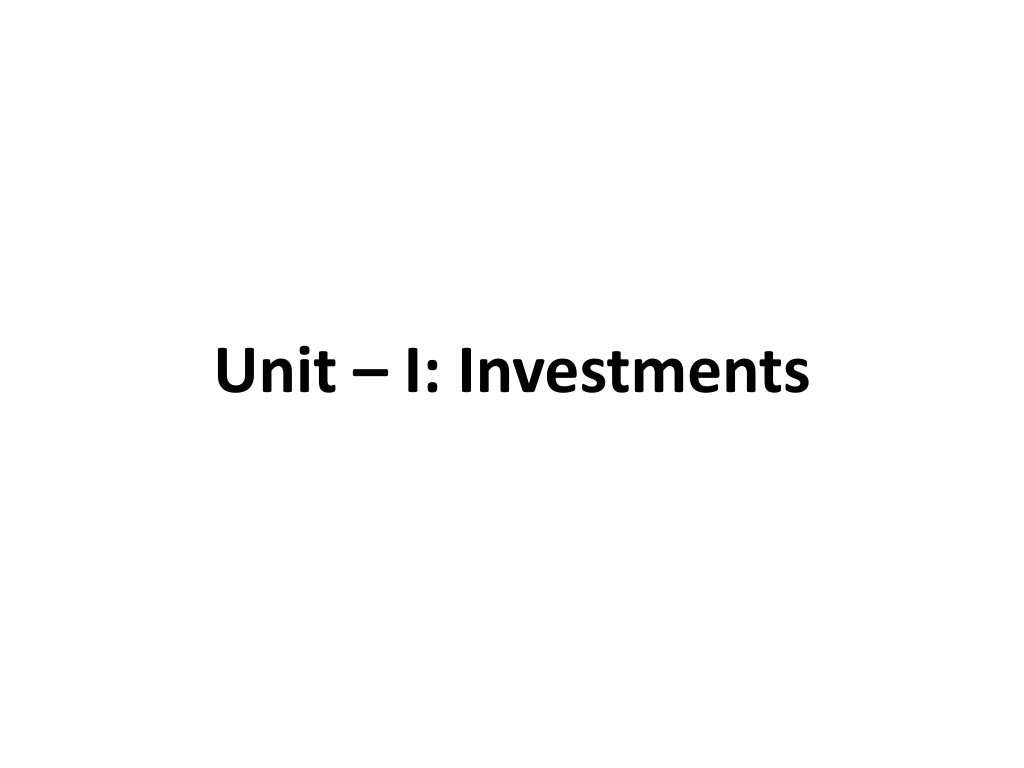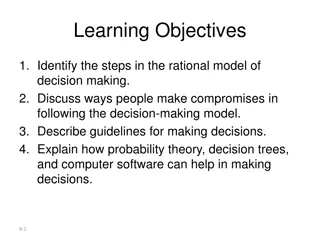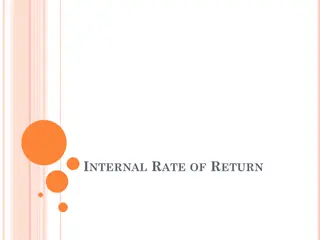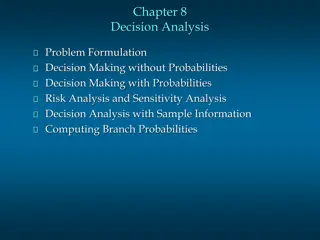Investments: Objectives, Decision Making, and Goals
Investments involve committing money for future benefits, balancing risk and return. The nature, scope, and objectives of investments guide decision-making processes, considering factors like time, risk, and diversification. Investment goals range from short-term to long-term priorities, aiming to increase returns, manage risks, ensure liquidity, and hedge against inflation. The investment process includes defining policies, analyzing options, valuing securities, constructing portfolios, and evaluating performance. Differentiating investments from speculation is essential for making informed financial decisions.
Download Presentation

Please find below an Image/Link to download the presentation.
The content on the website is provided AS IS for your information and personal use only. It may not be sold, licensed, or shared on other websites without obtaining consent from the author.If you encounter any issues during the download, it is possible that the publisher has removed the file from their server.
You are allowed to download the files provided on this website for personal or commercial use, subject to the condition that they are used lawfully. All files are the property of their respective owners.
The content on the website is provided AS IS for your information and personal use only. It may not be sold, licensed, or shared on other websites without obtaining consent from the author.
E N D
Presentation Transcript
Definition of Investment: Investment is the current commitment of money for a particular period of time in order to derive anticipated future benefits that will compensate for: a) The time for committed. b) The expected rate of Inflation. C) The uncertainty of future payment. which funds are 2
Investments refers: To sacrifice of current resources in anticipation of a future benefit. Involves commitment of certain current cash flow in anticipation of an uncertain future cash flows. Involves employment of own funds or borrowed funds on a real or financial asset for a certain period of time in anticipation of a return in future. Refers to postponement of current consumption in anticipation of a future benefit. The investor can be an Individual, Government, Pension fund, or a Corporation. 3
Nature and Scope of Investment Decision: Higher the Risk, Higher is the Expected Return. A well diversified Unsystematic risk by a large way. Higher the time period of investment, lesser is the uncertainties of Investment. Investor prefers among securities which yield higher return for the same risk or lower risk for the same return. Investment decisions are based on Investment objectives and Constraints. Portfolio reduces 4
INVESTMENT OBJECTIVES/GOALS: Based on Time period and Priority, Investment Objectives can be classified into: Near term high priority goals. Long term high priority goals. Low priority goals. Entrepreneurial or Money making goals. 5
INVESTMENT OBJECTIVES/GOALS: The primary objective of any Investment is to increase the rate of return and to reduce the risk. However the other Objectives of Investment include: 1. Return. 2. Risk. 3. Liquidity. 4. Hedge against Inflation. 5. Safety. 6
Process of Investment Decision Making The Process of Investment Decisions Making involves five Stages: 1) Investment Policy 2) Investment Analysis 3) Valuation of Securities 4) Portfolio Construction 5) Portfolio Evaluation and Revision.
INVESTMENT Vs SPECULATION: Investments are carefully thought out decisions which involves calculated speculation on the other hand is based on rumors, hearsay, tips etc. An investor has a relatively longer time horizon compared to that of a speculator. An investor is generally risk averse whereas a speculator is generally risk prone. An investor s expected return is consistent with the underlying risk of the investment whereas risk assumed by a speculator and his anticipated return is disproportionate. risk whereas 8
Investments are generally made based on fundamentals whereas Speculations are done based on rumors, tips etc An Investor generally uses his own funds whereas a speculator normally goes for borrowed funds to leverage his investments. The volumes of trade of an investor is generally smaller than that of a speculator. Investor generally follows passive approach whereas speculator approach. follows an active 9
Investor generally invests in a well diversified portfolio whereas speculator generally puts his money only in one or few stocks. Investor looks to profit from per unit return whereas Speculator looks to profit from bigger volumes of trade and gains from leverage effect. Investor expects regular income in the form of dividends whereas Speculator looks for Capital appreciation. 10
Security Vs Non Security: Security investments are traded in the market and are transferable in nature. Ex: Shares, Debentures etc. Non Security investments are neither traded nor transferable. Ex: Post office savings deposits, Deposits with commercial banks, etc. 11
INVESTMENT AVENUES OR ALTERNATIVES OR CHANNELS Bank Deposits Post office Deposits Insurance Mutual Fund Equities share Preference shares Debentures. Bonds 12
INVESTMENT AVENUES OR ALTERNATIVES Real estate. Provident fund. Derivative market. Commodity market. Currency market. Gold. Money market instruments. Precious and Artistic articles. 13
INVESTMENT ATTRIBUTES: Expected Return (ROI). Risk. Marketability. Tax benefit (IF ANY). Convenience / ease. 14
INVESTMENT PROCESS Setting up of Investment Objectives. Choice of Asset mix. Formulation of Portfolio strategy. Selection of securities. Portfolio Execution. Portfolio Revision. Portfolio Evaluation. 15
Meaning of Risk: In the financial world, risk can be defined as any event or possibility of an event which can impair corporate earnings or cash flow over short/medium/long-term horizon. In other words, the potential for future returns to vary from the expected returns is risk.
The concept of Risk: An unwanted event which may or may not occur. The cause of an unwanted event which may or may not occur. The probability of an unwanted event which may or may not occur. The statistical expectation value of unwanted events which may or may not occur. The fact that a decision is made under conditions of known probabilities ( decision making under risk )
Need and Scope of Risk: All organisations deal with risks, though the nature and magnitude may differ for each type of organisation. This is especially true for banks/financial institutions, as they deal with money. They act as financial intermediaries in any economic system. They help in mobilizing household/corporate savings and making them available to deficit units by way of providing loans.
Risk-Return Trade-Off: The relation between risk and return that usually holds, in which one must be willing to accept greater risk if one wants greater returns, also called risk/reward trade-off. to pursue 19
SOURCES & TYPES OF RISK: Sources of Risk: The following are the different sources of risk: 1)Interest Rate Risk 2)Market Risk 3)Inflation Risk 4)Business Risk 5)Financial Risk 6)Liquidity Risk 7)Exchange Rate Risk 8)Country Risk 20
TYPES OF RISK: The following are the different types of risk: 1)Systematic Risk: Virtually all securities have some systematic risk, whether bonds or stocks, because systematic risk directly encompasses the interest rate, market, and inflation risks. The investor cannot escape this part of the risk, because no matter how well he or she diversifies, the risk of the overall market cannot be avoided. 21
2) Non Systematic Risk: Non-Systematic Risk is the variability in a security s total returns not related to overall market variability is called the non-systematic risk. Although all securities tend to have some non-systematic generally connected with common stocks. risk, it is 22
Risk Aversion & Risk Premium RISK AVERSION: Risk aversion is the reluctance of a person to accept a bargain with an uncertain payoff rather than another bargain with a more certain, but possibly lower, expected payoff. For example, a risk-averse investor might choose to put his or her money into a bank account with a low but guaranteed interest rate, rather than into a stock/mutual fund that may have high expected returns, but also involves a chance of losing value. 23
RISK PREMIUM Risk premium is the minimum amount of money by which the expected return on a risky asset must exceed the known return on a risk-free asset, or the expected return on a less risky asset, in order to induce an individual to hold the risky asset rather than the risk-free asset. (Note that risk premia may be negative.) Thus it is the minimum willingness to accept compensation for the risk. 24
FUNDAMENTAL & TECHNICAL ANALYSIS FUNDAMENTAL ANALYSIS is the approach that uses information derived from supply and demand factors to anticipate price movements. Fundamental analysts use monthly reports that project supply and demand factors for a particular commodity, along with information from various associations. 25
Technical analysis Technical analysis is the approach that uses futures price charts to anticipate price movements. Technical analysts use bar charts of market trends and turning points to develop price forecasts. They also use price movements from past days, weeks, months, and years to research price trends. 26
Efficient Market Hypothesis In finance, the efficient-market hypothesis (EMH), or the joint hypothesis problem, state that "informationally efficient". In consequence of this, one cannot consistently achieve returns in excess of average market returns on a risk-adjusted basis, given the information available at the time the investment is made. financial markets are 27
There are three major versions of the hypothesis: 1) "weak": The weak-form EMH claims that prices on traded assets (e.g., stocks, bonds, or property) already reflect all past publicly available information. 2) "semi-strong": The semi-strong-form EMH claims both that prices reflect all publicly available information and that prices instantly change to reflect new public information. 3) "strong": The strong-form EMH additionally claims that prices instantly reflect even hidden or "insider" information. 28
Behavioral Finance A theory of finance that attempts to explain the decisions of investors by viewing them as rational actors looking for their self-interest, given the sometimes inefficient nature of the market. The Theory of Moral Sentiments, one of its primary observations holds that investors and people in general make decisions on imprecise impressions and beliefs rather than rational analysis. (Ex: Muhurth Trading on the day of Diwali). 29
A second observation states that the way a question or problem is framed to an investor will influence the decision he/she ultimately makes. These two observations largely explain market inefficiencies; that is, behavior finance holds that markets are sometimes inefficient because people are not mathematical equations. 30
Heuristic-Driven Bias Heuristic-Driven Bias refers to the process by which people find things out for themselves, usually by trial and error. Trial and error leads people to develop rules of thumb which often causes errors.
Heuristic-Driven Bias Representativeness > Refers to judgments based on stereotypes. > People believe that a small sample is representative of the entire population.
Heuristic-Driven Bias Overconfidence > People set overly narrow confidence intervals. > They get surprised more frequently than they anticipate.
Heuristic-Driven Bias Anchoring-and-Adjustment: > People do not adjust their expectations sufficiently in response to new information. > They are anchored to their initial expectations.
End of Unit-1 Thank You!!!























